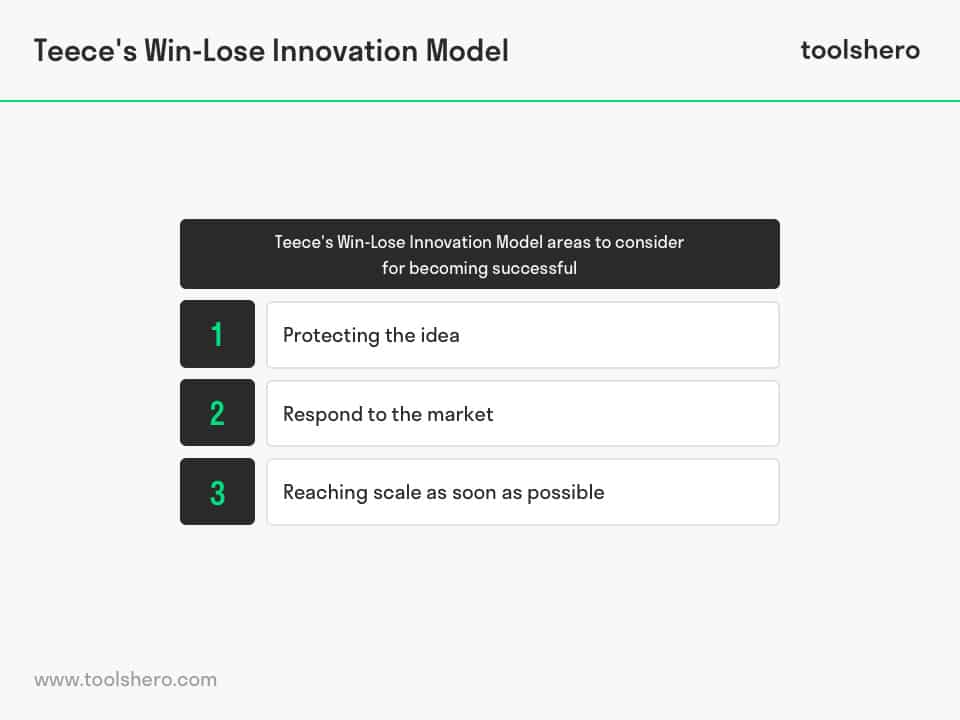Teece’s Win-Lose Innovation Model

Teece’s Win-Lose Innovation Model: this article explains Teece’s Win-Lose Innovation Model in a practical way. After reading, you’ll understand the basics of this powerful strategy tool.
What is Teece’s Win-Lose Innovation Model?
Teece’s Win-Lose Innovation Model describes the required steps that organizations should take to make sure that they can benefit from innovations.
More importantly, Teece’s win-lose innovation model is concerned with maintaining innovations so that rival companies cannot easily replicate an innovation and also benefit from the results.
According to Teece’s win-lose innovation model, there are innovators and imitators. Innovators are the ones who create a new idea and bring it to the market.
The imitators are the ones who duplicate a part of the innovation or the whole innovation, and next, launch this duplicated innovation on the market and present it as their creation.
For this reason, particularly businesses that are referred to as innovators, should create a protection strategy so that imitators cannot easily copy innovations.
However, in reality, most innovations do not become successful. Only a small portion of innovations reach the growth and maturity stages of a product life cycle. Many times, after an innovative solution is introduced, it immediately enters the decline phase.
It is rare that many innovative solutions actually reach the growth and maturity stage of a product lifecycle. This means that if one innovation becomes successful, rival companies are desperately seeking for ways to copy the innovation. For this reason, and based upon Teece’s win-lose innovation model, businesses need appropriate law protection.
The Teece’s win-lose innovation model identified various steps that can be taken into account to make sure an innovation can be protected and cannot easily be copied so that the inventor can profit most of the innovation. The steps involved in Teece’s win-lose innovation model are in the next section described more in detail.
Teece’s Win-Lose Innovation Model areas to consider for becoming successful
1. Protecting the idea
Protecting an innovation can be done in different ways, but the type of protection depends on the innovation. A crucial element of protecting an idea is to apply for intellectual protection.
This is a protection of the creation of the mind, such as an invention, design, symbol, and a name. Intellectual protection can be protected by patents, copyrights, and trademarks.
Protecting the idea with intellectual property protection is an effective way to gain the most benefits out of an innovation before a rival company reaps the benefits of the inventor’s creation.
According to Teece’s Win-Lose Innovation Model, it is crucial to get the most comprehensive protection for as long as possible.
It is additionally essential to evaluate local law and regulations and compare these with the expected investment in terms of human capital but also the monetary investments.
When the benefits are critically analyzed, it becomes more evident if a particular idea is worth investing in. The bottom line is that proper protection is needed if an inventor wants the reap the most benefits out of an innovation.
2. Respond to the market
By this time, there is awareness that an innovation needs protection. The Teece’s Win-Lose Innovation Model now urges inventors to analyze the market environment such as competitors, but also the speculated demand for the innovation.
By analyzing competing companies, the inventor can still make changes to the innovation if rival companies have similar innovations. This is essential because it helps to understand what type of strategy is required to capture the largest market share.
Another reason to analyze competitors is that it is highly likely that these companies will improve an innovation once it has been launched on the market.
These organizations will probably deconstruct the innovation and determine shortcomings that the original inventor was unaware of.
For this reason and according to Teece’s Win-Lose Innovation Model, analyzing rival companies will in the long-run gain competitive advantages because modifying an invention is easier than creating a new one.
If the innovation turns out to be successful, it is of high importance to capture market share as fast as possible and build brand equity. This is essential because regardless of the level of intellectual protection, imitators will always be able to copy the innovations once it has captured a large market.
For this reason, inventors must still analyze the market environment, including potential to create a positive image of the original brand.
3. Reaching scale as soon as possible
Teece’s Win-Lose Innovation Model advice in this step that that as soon as an innovation is capturing market share and when demand is increasing, it is best to scale up the volume as quickly as possible.
It is crucial because if an inventor is not able to keep up with the demand, competitors will gain the available market share. When the output of the invention can be maximized, it will gain more control over the production process and where it will be distributed and redistributed.
Teece’s Win-Lose Innovation Model states that if an inventor does not have the resources to upscale the production, it is possible to outsource the production of the innovation.
However, when such processes are outsourced, there is less control over the operations. It means that mistakes can be made more quickly, and the innovation can more easily be copied.
Many times, when businesses must decide how to upscale production if they do not possess all resources to keep up with demand, these businesses utilize a mix insourced and outsources production strategies.
The strategies insourcing and outsourcing have pros and cons. However, it depends on the type of business and industry which strategy a business should utilize.
A final word on Teece’s Win-Lose Innovation Model
It many times happens that the creators of innovations lose a large part of the potential marketing share to competitors. The loss also depends on the knowledge the competitors have.
When an innovation is build based upon tacit knowledge, a knowledge that cannot easily be codified articulated, stores, and assessed, it is less likely the innovation can be copied easily. This would protect the innovation from being imitated, and thus, stabilize the market share of the inventor.
By focusing on closed innovation based on tactic knowledge, companies invest more time and money, but the return will be higher when they have captured a large share of the market.
Focusing on open or closed innovation depends on the situation because if an innovation is not fully developed yet, it would be better to focus on open innovation. In this way, the innovation would be further improved by other companies.
Now it’s your turn
What do you think? Do you recognize the explanation about Teece’s Win-Lose Innovation Model? Are you familiar with how rapidly innovations are copied? Do you perhaps know innovations that are not easy to copy? Do you have any tips or additional comments?
Share your experience and knowledge in the comments box below.
More information
- Du Chatenier, E., Verstegen, J. A., Biemans, H. J., Mulder, M., Omta, O. (2009). The challenges of collaborative knowledge creation in open innovation teams. Human Resource Development Review, 8(3), 350-381.
- Engel, J. S. (2014). Global clusters of innovation: Entrepreneurial engines of economic growth around the world. Edward Elgar Publishing.
- Hock, M., Clauss, T., Schulz, E. (2016). The impact of organizational culture on a firm’s capability to innovate the business model. RD Management, 46(3), 433-450.
- Johannessen, J. A., Olsen, B., Olaisen, J. (1997). Organizing for innovation. Long range planning, 30(1), 96-109.
- Liu, R. (2013). Cooperation, competition and coopetition in innovation communities. Prometheus, 31(2), 91-105.
- Teece, D. J. (1986). Profiting from technological innovation: Implications for integration, collaboration, licensing and public policy. Research policy, 15(6), 285-305.
- Teece, D. J. (1991). Capturing Value from Innovation. Journal of the Executive Licensing Agency.
- Walsh, J. P., Lee, Y. N., Jung, T. (2016). Win, lose or draw? The fate of patented inventions. Research Policy, 45(7), 1362-1373.
- Wikhamn, B. R., Knights, D. (2011). Transaction cost economics and open innovation: Reinventing the wheel of boundary. Paper for DRUID 2011.
How to cite this article:
Zeeman, A. (2019). Teece’s Win-Lose Innovation Model. Retrieved [insert date] from toolshero: https://www.toolshero.com/strategy/teece-win-lose-innovation-model/
Published on: 01/23/2019 | Last update: 05/24/2022
Add a link to this page on your website:
<a href=”https://www.toolshero.com/strategy/teece-win-lose-innovation-model/”>toolshero: Teece’s Win-Lose Innovation Model</a>













